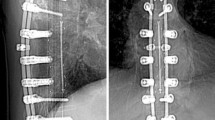Abstract
Purpose
We evaluated 18F-fluoride PET/CT for the diagnosis of screw loosening after intervertebral fusion stabilization and compared the results with those from functional radiography.
Methods
A group of 59 patients with pain in the region of previous intervertebral fusion stabilization and suspicion of implant instability due to screw loosening were investigated with 18F-fluoride PET/CT and functional radiography, 30.1 ± 3.4 and 29.3 ± 3.2 months, respectively, after surgery. The criterion for loosening was increased focal uptake surrounding the screw entry point and shaft. SUVmax and SUVmean were measured in a region of interest (ROI) drawn around each screw (334 screws analysed). The final diagnosis was established by surgical exploration in 27 patients and clinical follow-up after intervertebral fusion stabilization in 32 patients.
Results
Of the 59 patients, 20 were proven positive for implant failure due to screw loosening and 39 were confirmed negative. The sensitivity, specificity and accuracy of 18F-fluoride PET/CT were 75 %, 97.4 % and 89.8 % in the patient-based analysis, and 45.6 %, 100 % and 80 % in the screw-based analysis, respectively. The positive and negative predictive values were 93.8 % and 100 % in the patient-based analysis, and 88.4 and 76 % in the screw-based analysis, respectively. CT signs in PET/CT allowed screw breakage to be detected in three patients. SUVmax, SUVmean and SUVmax/SUVmean ratios in screw ROIs and respective values in reference regions were all found to be significantly different between screws positive for loosening (58 screws) and screws negative for loosening (276 screws). The ratio between SUVmax in screw ROIs and the values in reference regions was the most significant parameter for distinguishing screws positive and screws negative for loosening.
Conclusion
18F-Fluoride PET/CT imaging is useful for the diagnosis of screw loosening in patients with persistent symptoms after intervertebral fusion stabilization.


Similar content being viewed by others
References
Lawhorne TW, Girardi FP, Mina CA, Pappou I, Cammisa Jr FP. Treatment of degenerative spondylolisthesis: potential impact of dynamic stabilization based on imaging analysis. Eur Spine J. 2009;18:815–22.
Wu Z, Gong F, Liu L, Ma ZS, Zhang Y, Zhao X, et al. A comparative study on screw loosening in osteoporotic lumbar spine fusion between expandable and conventional pedicle screws. Arch Orthop Trauma Surg. 2012;132:471–6.
Brox JI, Nygaard ØP, Holm I, Keller A, Ingebrigtsen T, Reikerås O. Four-year follow-up of surgical versus non-surgical therapy for chronic low back pain. Ann Rheum Dis. 2010;69:1643–8.
Fritsch EW, Heisel J, Rupp S. The failed back surgery syndrome: reasons, intraoperative findings, and long-term results: a report of 182 operative treatments. Spine. 1996;21:626–33.
Nasser R, Yadla S, Maltenfort MG, Harrop JS, Anderson DG, Vaccaro AR, et al. Complications in spine surgery. J Neurosurg Spine. 2010;13:144–57.
Papadakis M, Aggeliki L, Papadopoulos EC, Girardi FP. Common surgical complications in degenerative spinal surgery. World J Orthop. 2013;4:62–6.
Kosmopoulos V, Schizas C. Pedicle screw placement accuracy – a meta-analysis. Spine. 2007;32:E111–20.
Tohtz SW, Rogalla P, Taupitz M, Perka C, Winkler T, Putzier M. Inter- and intraobserver variability in the postoperative evaluation of transpedicular stabilization: computed tomography versus magnetic resonance imaging. Spine J. 2010;10:285–90.
Larsen JM, Rimoldi RL, Capen DA, Nelson RW, Nagelberg S, Thomas Jr JC. Assessment of pseudarthrosis in pedicle screw fusion: a prospective study comparing plain radiographs, flexion/extension radiographs, CT scanning, and bone scintigraphy with operative findings. J Spinal Disord. 1996;9:117–20.
Rutherford EE, Tarplett LJ, Davies EM, Harley JM, King LJ. Lumbar spine fusion and stabilization: hardware, techniques, and imaging appearances. Radiographics. 2007;27:1737–49.
Even-Sapir E, Martin RH, Mitchell MJ, Iles SE, Barnes DC, Clark AJ. Assessment of painful late effects of lumbar spinal-fusion with SPECT. J Nucl Med. 1994;35:416–22.
Lusins JO, Danielski EF, Goldsmith SJ. Bone SPECT in patients with persistent back pain after lumbar spine surgery. J Nucl Med. 1989;30:490–6.
Damgaard M, Nimb L, Madsen JL. The role of bone SPECT/CT in the evaluation of lumbar spinal fusion with metallic fixation devices. Clin Nucl Med. 2010;35:234–6.
Brans B, Weijers R, Halders S, Wierts R, Peters M, Punt I, et al. Assessment of bone graft incorporation by 18F-fluoride positron-emission tomography/computed tomography in patients with persisting symptoms after posterior lumbar interbody fusion. EJNMMI Res. 2012;2:42–9.
Quon A, Dodd R, Iagaru A, de Abreu MR, Hennemann S, Neto JM, et al. Initial investigation of 18F-NaF PET/CT for identification of vertebral sites amenable to surgical revision after spinal fusion surgery. Eur J Nucl Med Mol Imaging. 2012;39:1737–44.
Grob D, Mannion AF. The patient’s perspective on complications after spine surgery. Eur Spine J. 2009;18:380–5.
Young PM, Berquist TH, Bancroft LW, Peterson JJ. Complications of spinal instrumentation. Radiographics. 2007;27:775–89.
Czernin J, Satyamurthy N, Schiepers C. Molecular mechanisms of bone 18F-NaF deposition. J Nucl Med. 2010;51:1826–9.
Grant FD, Fahey FH, Packard AB, Davis RT, Alavi A, Treves ST. Skeletal PET with 18F-fluoride: applying new technology to an old tracer. J Nucl Med. 2008;49:68–78.
Fischer DR, Zweifel K, Treyer V, Hesselmann R, Johayem A, Stumpe KD, et al. Assessment of successful incorporation of cages after cervical or lumbar intercorporal fusion with [18F]fluoride positron-emission tomography/computed tomography. Eur Spine J. 2011;20:640–8.
Fishman EK, Magid D, Robertson DD, Brooker AF, Weiss P, Siegelman SS. Metallic hip implants: CT with multiplanar reconstruction. Radiology. 1986;160:675–81.
Conflicts of interest
None.
Authors’ contributions
C.P., T.S., L.R. and W.P. made substantial contributions to the conception and design of the study, and interpretation of data. T.S., J.H. and M.M.C. carried out the acquisition of data, and contributed to the analysis of data. C.P. and M.R. performed the analysis and interpretation of data, and were involved in drafting the manuscript.
Each author gave final approval of the version to be published.
Author information
Authors and Affiliations
Corresponding author
Rights and permissions
About this article
Cite this article
Seifen, T., Rodrigues, M., Rettenbacher, L. et al. The value of 18F-fluoride PET/CT in the assessment of screw loosening in patients after intervertebral fusion stabilization. Eur J Nucl Med Mol Imaging 42, 272–277 (2015). https://doi.org/10.1007/s00259-014-2904-6
Received:
Accepted:
Published:
Issue Date:
DOI: https://doi.org/10.1007/s00259-014-2904-6




